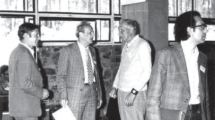Abstract
Kamioka Underground Observatoris consist of three different organizations. Super-Kamikande is operated by the Kamioka Observatory, Institute for Cosmic Ray Research (the University of Tokyo) and KamLAND is operated by Research Center for Neutrino Science (Tohoku University). Those experiments in the Kamioka Underground Observatories have discovered neutrino oscillations and also made tremendous contributions on the oscillation studies after the discovery. The discovery of the neutrino oscillations was initially made by using the astrophysical neutrinos, but the experiments using man-made neutrinos from accelerators and nuclear reactors are also carried out. Underground we also have many devices necessary to achieve low-background environments. The Kamioka Satellite (Kavli Institute for the Physics and Mathematics of the Universe, University of Tokyo) provides indispensable devices for low-background experiments. They are commonly used. We also supply Rn-free air and pure water. The number of experiments underground have been increasing recently, including some R&D projects. Nowadays other fields of science like geo-physics are also pursued in the underground observatories. We have a future plan to scale up the Super-Kamiokande further, to be called Hyper-Kamiokande, and there will be a variety of possibilities using the KamLAND detector as a low-background environment. The full scale XMASS will also be an interesting future project.
Similar content being viewed by others
References
K. Hirata et al., Phys. Rev. Lett. 58, 1490 (1987).
K.S. Hirata et al., Phys. Rev. Lett. 63, 16 (1989).
R. Davis jr. et al., Phys. Rev. Lett. 20, 1205 (1968).
J.N.Bahcall et al., Phys. Rev. Lett. 20, 1209 (1968).
K.S. Hirata et al., Phys. Lett. B 205, 416 (1988).
Y. Fukuda et al., Phys. Rev. Lett. 81, 1562 (1998).
E. Aliu et al., Phys. Rev. Lett. 94, 081802 (2005).
S. Fukuda et al., Phys. Rev. Lett. 86, 5651 (2001).
Q.R. Ahmad et al., Phys. Rev. Lett. 87, 071301 (2001).
K. Eguchi et al., Phys. Rev. Lett. 90, 021802 (2003).
K. Abe et al., Phys. Rev. Lett. 107, 041801 (2011).
A. Gando et al., Phys. Rev. C 86, 021601 (2012).
M. Auger et al., Phys. Rev. Lett. 109, 032505 (2012).
Y. Suzuki, hep-ph/0008296 (2000).
K. Abe, arXiv:1109.3262.
J.F. Beacom, M. Vagins, Phys. Rev. Lett. 93, 171101 (2004).
Author information
Authors and Affiliations
Corresponding author
Rights and permissions
About this article
Cite this article
Suzuki, Y., Inoue, K. Kamioka Underground Observatories. Eur. Phys. J. Plus 127, 111 (2012). https://doi.org/10.1140/epjp/i2012-12111-2
Received:
Accepted:
Published:
DOI: https://doi.org/10.1140/epjp/i2012-12111-2




